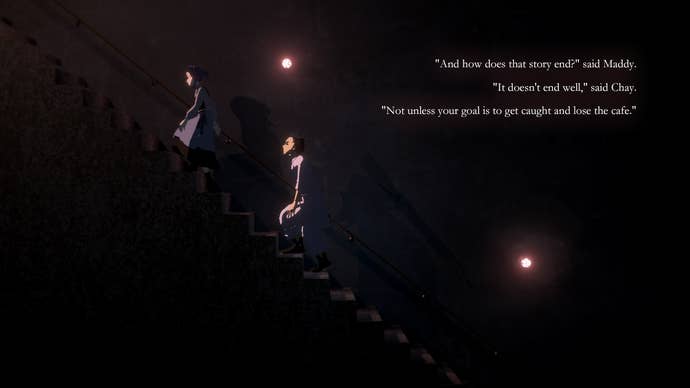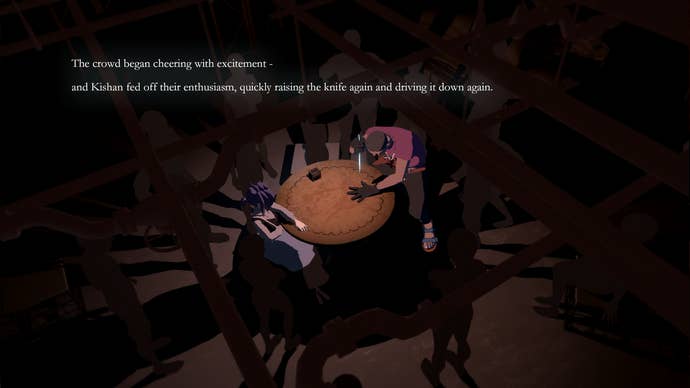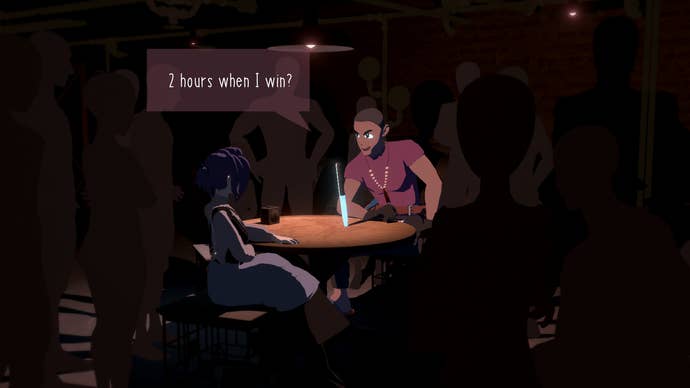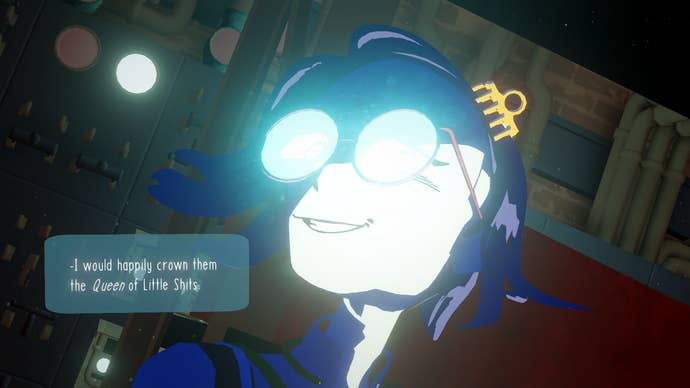How Necrobarista Looks to Anime to Evolve the Visual Novel
We talked to the designers and artists behind the most artistically innovative visual novel on the horizon.
This article first appeared on USgamer, a partner publication of VG247. Some content, such as this article, has been migrated to VG247 for posterity after USgamer's closure - but it has not been edited or further vetted by the VG247 team.
You might have seen a bit of Necrobarista by now, or at least heard its memorable name. It's a game that dominated headlines when a mere teaser trailer dropped at the start of the year, despite emerging from the depths of relative unknowns in the industry. What made it stand out was its undeniable flair for style: just as Guilty Gear Xrd redefined how 2D animation looks in 3D, the four-person team of Route 59 are hoping to do the same for visual novels, and beyond.
Necrobarista is a visual novel in development for the Nintendo Switch, PC, and Mac. Looking at it casually, its heritage is not obvious. That's because it's in full-3D, which is uncommon for the genre. Typically, visual novels are driven by intricate storytelling with words alone (and maybe flashy, stagnant art alongside it); essentially acting as interactive books to get lost in. Necrobarista instead looks to animation for inspiration, and watching it in motion, feels like true animation too.
"[A big part of what drives us is] pushing not so much visual novels forward, but anime art in games," said Kevin Chen, lead designer and art director on Necrobarista. Chen's known most of the team behind the game for years. He's known character designer and animator Ngoc Vu for around five years, 3D artist Joe Liu since high school, and writer Justin Kuiper just happened to work out as an employee back in 2015. Together, the group is the backbone behind Necrobarista.
The idea for the game spurred from Chen, Vu, and Liu's time studying in school, where they took a Unity class together. Eventually, the three of them clicked and they decided to pursue a professional project as a team. (Kuiper was hired later, after development had already started.) Coupled by a love for Japanese animation and manga, it was nearly destined to be.

The setting for Necrobarista, as I'm told explicitly by Chen, isn't a super unique one. It's about a supernatural cafe where the undead swing by to grab one last cup of joe before peacing out to the afterlife. It's kind of a purgatory, which is commonly seen across all sorts of mediums. ("I'm sure it's been done before in games. [Like] if you look at the anime Death Parade, which I have to say came out after we started working on the story, so no, we did not take that for inspiration," directly noted Chen.) The game looks immediately unfamiliar in terms of how it's framed though. Even with its Japanese influences, it has one key difference from the Japanese visual novels that influenced the project: it takes place in Melbourne, Australia, not Japan.
"We wanted to do a story that wasn't set in Japan because it would just end up being an inferior version of the stories that Japanese developers do, because they're Japanese, they're in Japan and they know it way better than we know Japan," said Chen. "[A lot of] Western-based visual novels I see try to be set in Japan, and I'm not sure if that's a familiarity thing. [Like] okay, if you guys are going to do a western visual novel, why don't you guys just set it in the west instead of Japan? So we kinda want to respond to that, like yeah sure. Let's do something that's not set in Japan."
Their influences are familiar to anyone who keeps their ears close to the anime scene. Vu muses about her love for early-to-mid-2000s anime, like Soul Eater, Gurren Lagann, and Eureka 7. She also enjoys the works of Capcom character artist Kinu Nishimura, manga artist Yusuke Murata, and animator Yoh Yoshinari. "In Australia, we have a very limited number of animations. We had cable so I'd watch Cartoon Network and stuff like that, and that got me into the whole animation stream," said Vu. "One of my cousins introduced me to anime; they'd lend me the DVDs and I'd be like 'This is so different to the Powerpuff Girls!' I just really liked the way they rendered their effects animation, fight scenes; it was just so cinematic and detailed."


That detail carries over into Necrobarista, a visual novel that's far more cinematic than most of its kind. The camera swirls around characters, showing that they are 3-dimensional figures and not flat assets; their glasses shimmer when the light hits them just right, almost in Gendo Ikari style. Necrobarista is redefining the genre it lives in by making it more of a pleasure to watch, rather than just a delight to read.
Elsewhere, Chen's inspirations are notably darker, maybe alluding to how the "necro" in Necrobarista even got its name. "I was born in Taiwan but I moved to Australia at the age of five. I did grow up more immersed in that culture. Taiwan in general is very, I suppose, heavily influenced by Japan due to the cultural overlap from World War II. So, I had access to that medium from a much earlier age," said Chen. "Regarding influences that directly had impact on Necrobarista, Akiyuki Shinbo is a director that works at Shaft, which is an animation studio. He's responsible for shows like Madoka Magica, Monogatari series. He has a very unique editorial style that I really admire."
In the minimal footage released of the 2018 game so far, Shaft animation studio's influence is clear. Characters often get uncomfortably close to the screen, characters tilt their head backwards in impossible ways as they deliver sinister monologues. When I first saw a trailer for the game so long ago, Shaft was the first thing I thought of. And like Shaft, Necrobarista brings all its influences into the fold, but ushers them into new uncharted directions too.

Part of that's possible because of the use of Unity, rather than a traditional visual novel engine such as Ren'Py. "We're using a 3D engine to render all our scenes," Chen explained. "This gives us a much much larger degree of flexibility of what we can portray, and what kind of angles we can show inside the game. Literally taking maximum advantage of spaces. […] We really want to spice things up a bit, and use the camera to tell a story as much as the actors."
Visual novels are so often confined to words and motionless art. There have been visual novels that have innovated upon themselves—the first to come to mind is Christine Love's Ladykiller in a Bind, which while more of a dating sim than a traditional visual novel, has an innovative dialogue system where options change the longer you wait. Necrobarista, giving its characters more freedom to move and communicate almost feels like you're watching a 3D anime, rather than reading along to the tune of a video game.
"[Since] the 1990s, visual novels have kind of remained the same. 2D sprites on a 2D background on the top, branching choices, save points. That kind of stuff," said Chen. "But no one has really, really pushed the medium. That's what we want to do with Necrobarista, [it's] a love letter to the fans and the games that we always loved, but also stepping forward and integrating parts from the other mediums that we really like, such as anime and manga, and trying to bridge that gap between the mediums because the technology really is there."

